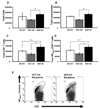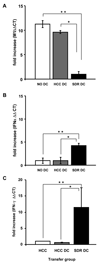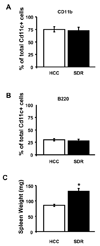Immunogenic dendritic cells primed by social defeat enhance adaptive immunity to influenza A virus
- PMID: 20656014
- PMCID: PMC2991426
- DOI: 10.1016/j.bbi.2010.07.243
Immunogenic dendritic cells primed by social defeat enhance adaptive immunity to influenza A virus
Abstract
Dendritic cells (DCs) sample their surrounding microenvironment and consequently send immunogenic or regulatory signals to T cells during DC/T cell interactions, shaping the primary adaptive immune response to infection. The microenvironment resulting from repeated social defeat increases DC co-stimulatory molecule expression and primes DCs for enhanced cytokine responses in vitro. In this study, we show that social disruption stress (SDR) results in the generation of immunogenic DCs, capable of conferring enhanced adaptive immunity to influenza A/PR/8/34 infection. Mice infected with influenza A/PR/8/34 virus 24 h after the adoptive transfer of DCs from SDR mice had significantly increased numbers of D(b)NP(366-74)CD8(+) T cells, increased IFN-γ and IFN-α mRNA, and decreased influenza M1 mRNA expression in the lung during the peak primary response (9 days post-infection), compared to mice that received DCs from naïve mice. These data demonstrate that repeated social defeat is a significant environmental influence on immunogenic DC activation and function.
Copyright © 2010 Elsevier Inc. All rights reserved.
Figures




References
-
- Adler HS, Steinbrink K. Tolerogenic dendritic cells in health and disease: friend and foe! Eur J Dermatol. 2007;17:476–491. - PubMed
-
- Angeli A, Masera RG, Sartori ML, Fortunati N, Racca S, Dovio A, Staurenghi A, Frairia R. Modulation by cytokines of glucocorticoid action. Ann N Y Acad Sci. 1999;876:210–220. - PubMed
-
- Avitsur R, Kavelaars A, Heijnen C, Sheridan JF. Social stress and the regulation of tumor necrosis factor-alpha secretion. Brain Behav Immun. 2005;19:311–317. - PubMed
-
- Bailey MT, Engler H, Powell ND, Padgett DA, Sheridan JF. Repeated social defeat increases the bactericidal activity of splenic macrophages through a Toll-like receptor-dependent pathway. Am J Physiol Regul Integr Comp Physiol. 2007;293:R1180–R1190. - PubMed
Publication types
MeSH terms
Substances
Grants and funding
LinkOut - more resources
Full Text Sources
Molecular Biology Databases
Research Materials
Miscellaneous

